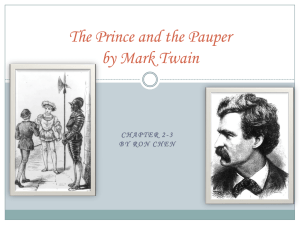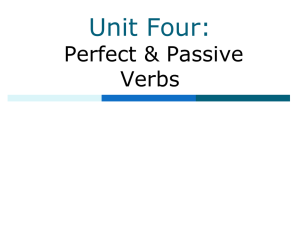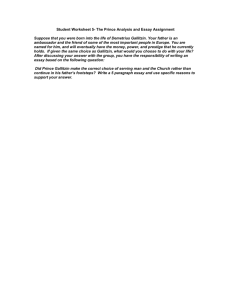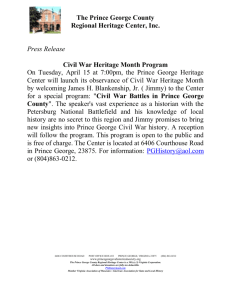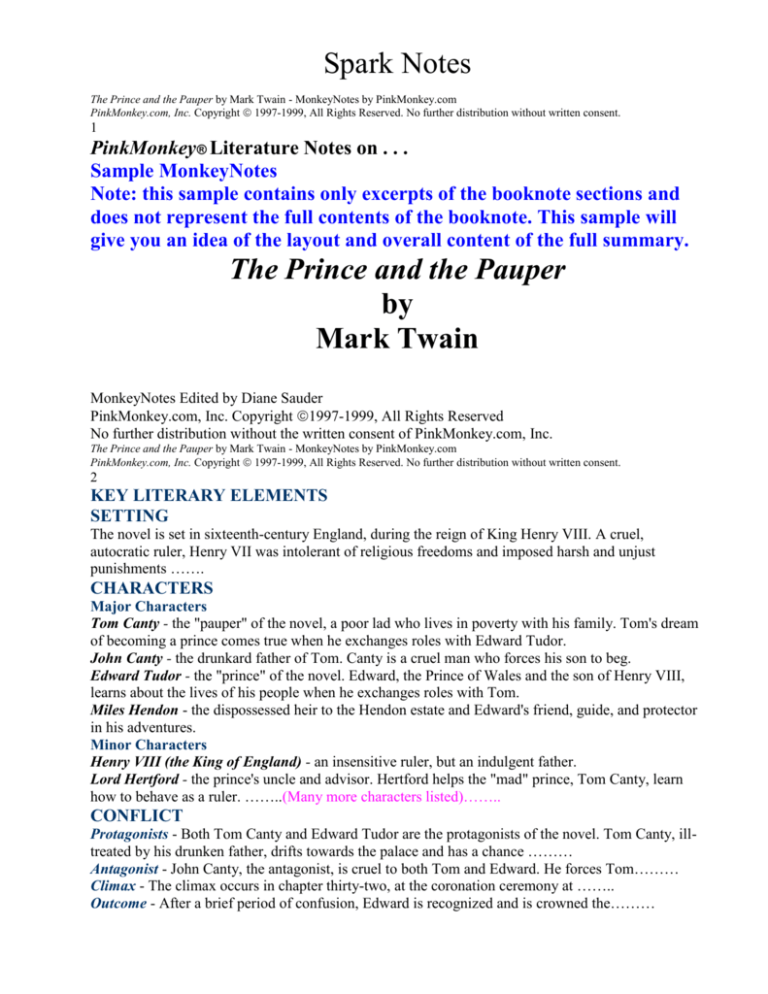
Spark Notes
The Prince and the Pauper by Mark Twain - MonkeyNotes by PinkMonkey.com
PinkMonkey.com, Inc. Copyright 1997-1999, All Rights Reserved. No further distribution without written consent.
1
PinkMonkey® Literature Notes on . . .
Sample MonkeyNotes
Note: this sample contains only excerpts of the booknote sections and
does not represent the full contents of the booknote. This sample will
give you an idea of the layout and overall content of the full summary.
The Prince and the Pauper
by
Mark Twain
MonkeyNotes Edited by Diane Sauder
PinkMonkey.com, Inc. Copyright 1997-1999, All Rights Reserved
No further distribution without the written consent of PinkMonkey.com, Inc.
The Prince and the Pauper by Mark Twain - MonkeyNotes by PinkMonkey.com
PinkMonkey.com, Inc. Copyright 1997-1999, All Rights Reserved. No further distribution without written consent.
2
KEY LITERARY ELEMENTS
SETTING
The novel is set in sixteenth-century England, during the reign of King Henry VIII. A cruel,
autocratic ruler, Henry VII was intolerant of religious freedoms and imposed harsh and unjust
punishments …….
CHARACTERS
Major Characters
Tom Canty - the "pauper" of the novel, a poor lad who lives in poverty with his family. Tom's dream
of becoming a prince comes true when he exchanges roles with Edward Tudor.
John Canty - the drunkard father of Tom. Canty is a cruel man who forces his son to beg.
Edward Tudor - the "prince" of the novel. Edward, the Prince of Wales and the son of Henry VIII,
learns about the lives of his people when he exchanges roles with Tom.
Miles Hendon - the dispossessed heir to the Hendon estate and Edward's friend, guide, and protector
in his adventures.
Minor Characters
Henry VIII (the King of England) - an insensitive ruler, but an indulgent father.
Lord Hertford - the prince's uncle and advisor. Hertford helps the "mad" prince, Tom Canty, learn
how to behave as a ruler. ……..(Many more characters listed)……..
CONFLICT
Protagonists - Both Tom Canty and Edward Tudor are the protagonists of the novel. Tom Canty, illtreated by his drunken father, drifts towards the palace and has a chance ………
Antagonist - John Canty, the antagonist, is cruel to both Tom and Edward. He forces Tom………
Climax - The climax occurs in chapter thirty-two, at the coronation ceremony at ……..
Outcome - After a brief period of confusion, Edward is recognized and is crowned the………
PLOT (Synopsis)
The novel opens with the announcement of the birth of Tom Canty, a pauper, and Edward Tudor, the
Prince of Wales. The two boys grow up in different surroundings and are unaware of each other's
existence. Tom lives in Offal Court, one of the poorest localities of London, where his drunken father
forces him to beg in the streets. However, he finds time to learn Latin and read the books of Father
Andrew. The old legends and histories he reads haunt his mind, and he starts visualizing himself as
the prince. One day, after wandering about the streets, he walks towards the royal palace. The guards,
catching him gaping through the gates, accost him, but the prince comes to the boy’s rescue. He takes
Tom to his chambers and inquires about his
family. When Tom expresses a desire to wear princely clothes, he and the boy exchange their clothes.
The striking resemblance between them surprises the two boys. Then, on an impulse, Edward
……….
The Prince and the Pauper by Mark Twain - MonkeyNotes by PinkMonkey.com
PinkMonkey.com, Inc. Copyright 1997-1999, All Rights Reserved. No further distribution without written consent.
3
THEMES
Major Theme - The major theme of the novel is "appearance and reality" or "image and identity."
The protagonists of the novel fail to establish their identities and are………
Minor Themes - Two other themes are also present in the novel, "environmental determinism" and
"progressiveness of history." Mark Twain firmly believed that environment was responsible for the
behavior of a person and that with the progress of time individuals and society changed for the better.
Edward is born a prince and Tom a pauper. However, when they are forced by circumstances to…….
MOOD
The prevailing mood of the novel is serious, as the story is set in sixteenth-century England,
under…….
BACKGROUND INFORMATION
Samuel Langhorne Clemens (he later took the pen name Mark Twain) was born on November 30,
1835, in the village of Florida, Missouri. His father, John Marshall Clemens, a magistrate and
shopkeeper in Florida, was highly intelligent, but a strict disciplinarian. Twain's mother, Jane, was a
compassionate woman with a natural sense of humor. Twain had irregular schooling, and, after his
father's death in 1847, he took on a series of odd jobs, before becoming a printer's apprentice. When
his brother Orion founded the Hannibal Journal, Twain went to work for him as a compositor and
began writing comic pieces for the paper. At the age of seventeen he
wrote a comic story, "The Dandy Frightening the Squatter," which was published in the Boston
humor magazine, The Carpet-Bag.
In 1853, Twain, always restless, began traveling around America, doing odd jobs in printing,
occasionally rejoining his brother, who had moved to Iowa, before setting out again. In 1857, while
on assignment to write a series of humorous travel letters for the Keokuk, Iowa, Daily Post, Twain
met……….
LITERARY/ HISTORICAL INFORMATION
Mark Twain began writing The Prince and the Pauper in 1877. His inspiration from the novel came
from Charlotte M. Yonge's The Little Duke, set in tenth-century France, in which the young Richard
of Normandy becomes a more compassionate and wise ruler after his father is murdered and he
experiences a series of harrowing adventures in the world. Initially, Twain's intention was to set the
story in the……..
CHAPTER SUMMARIES WITH NOTES
Chapter 1: The Birth of The Prince And The Pauper
Summary
On "a certain autumn day in the second quarter of the sixteenth century," two infants are born to two
families, respectively, in two different parts of London. One infant is Edward Tudor, the Prince of
Wales, while the other is Tom Canty, the pauper, the son of a poor family. The prince is welcomed
into the world with rejoicing, while the pauper is ignored because he is an unwelcome guest to his
family.
Notes
In the fashion of a children’s classic, Mark Twain introduces the protagonists of the novel in the first
chapter.
The Prince and the Pauper by Mark Twain - MonkeyNotes by PinkMonkey.com
PinkMonkey.com, Inc. Copyright 1997-1999, All Rights Reserved. No further distribution without written consent.
4
Edward Tudor, the Prince of Wales, and Tom Canty, the pauper, are born on the same day. In this
brief chapter, Twain provides a striking contrast between the status of the two infants.
Edward Tudor, the heir to the English throne, is ushered into the world with pomp and show. Not just
the royal family, but the whole of England celebrates his birth. He is pampered by the family
members and the lords and ladies who come celebrate his birth. Tom Canty, on the other hand, lies
uncared for in his poor dwelling. While Edward Tudor is considered a boon to his family, Tom Canty
is regarded as a burden. The only similarity in the situations of the two infants is that they both are
blissfully unaware of the reactions caused by their birth. Twain's direct and simple style is highly
suitable to the narration of a children’s classic. He chronicles the events and states the reactions to it
in short, simple sentences. The importance of the royal birth is highlighted
through a detailed account of the event, while the insignificance of a pauper’s birth is conveyed
through a single sentence.
Chapter 2: Tom’s Early Life
Summary
A number of years have passed since the birth of Edward Tudor and Tom Canty. Tom lives in a
small, congested house in Offal Court, near London Bridge, with his two sisters, his parents, and
grandmother. While the parents sleep on a bed, the children and their grandmother occupy the floor.
Tom’s father is a thief and his grandmother is a beggar and both of them are drunkards. However, the
children inherit their mother’s goodness. Father Andrew, who stays in the neighborhood, instills in
them the value of good morals. He also teaches Tom reading and writing and familiarizes him with
the Latin language and ancient legends. Tom’s mind is thus filled with visions of princes and palaces.
With time, he starts behaving like a prince and comes to be considered as one by the children of Offal
Court.
Notes
Mark Twain concentrates on Tom’s early life in this chapter. Tom lives in Offal Court, a dismal
pocket in the neglected part of London, where drunkenness and fighting are common. His house is
congested and he is poorly treated by his father and grandmother, who force him to beg, beat him
regularly, and give him scraps to eat. Yet he is not unhappy because he has no knowledge of any
other kind of life. Tom stands out from the inmates of Offal Court through his love of reading and his
moral sense, instilled in him by Father Andrew. The old legends and ancient tales he reads fire his
imagination, and he escapes into a dream world in which live princes, courtiers, and lords. Often he
imagines himself to be a prince, dispensing with judgments in a royal court. Twain portrays Tom as a
boy endowed with little means but possessed with the ability and desire to lead a royal life. This
chapter thus sets the stage for Tom’s encounter with the prince………
OVERALL ANALYSES
CHARACTERS
Edward Tudor - Mark Twain portrays Edward Tudor as a prince who goes through the experience of
a pauper in order to emerge as a worthy king. In the novel, Edward travels from the security of
Westminster to the dingy confines of a prison cell. As he progresses in his journey, he transforms
himself from an innocent and impulsive child-prince to a mature and enlightened young man ready to
wisely rule a country.
The Prince and the Pauper by Mark Twain - MonkeyNotes by PinkMonkey.com
PinkMonkey.com, Inc. Copyright 1997-1999, All Rights Reserved. No further distribution without written consent.
5
As a prince, Edward is pampered and protected. His father, Henry VIII, showers him with affection,
and the palace staff attend to all his needs and wants. After a chance encounter with ……….
Tom Canty - Tom Canty, the son of a drunkard, is unlike his father in his nature and behavior. Born a
pauper, he dreams of becoming a prince. Though driven to the streets by John Canty, he hates to
extend his hand to beg. Instead, he loves to read and, under the tutelage of a kind old priest, even
learns Latin. He also……..
John Canty - John Canty is the uneducated and uncultured father of Tom Canty. He is a ruffian and a
drunkard who begs and steals for a living and mistreats his wife and children. He forces ………
Miles Hendon - Miles Hendon is the lovable protector and champion of the otherwise friendless
Edward. Handsome, chivalrous, just, and capable, he has all the qualities of a hero. He rescues
Edward………..
PLOT (Structure)
Mark Twain’s The Prince and the Pauper is not just a children’s classic but a historical novel,
echoing moral truths. Though the novel deals with the reversal of roles of two children and their
adventures in a strange world, it particularly focuses attention on the England during the sixteenth
century, a period of tremendous religious upheavals and despotic rule. Henry VIII was an insensitive
ruler who punished his subjects severely for petty crimes. The laws of the land were harsh and
superstition prevailed, clouding rational thinking. Through his novel, Mark Twain exposes the
hypocrisy and inhumanity of aristocracy. He also………
THEMES
The major theme of the novel is "image and identity." Twain shows that in most circumstances, one's
image is — or becomes — one's identity, because people respond to images, in this case clothes,
rather than essences. Not only the protagonists but also Miles Hendon face doubtful identities in the
novel due to the disparity between who they are and who they appear to be.
When Tom enters the palace and exchanges clothes with Edward, he observes that he resembles the
prince. So when the image and identity of the prince is reversed by his putting on of Tom's clothes,
confusion arises. The guard outside the palace mistakes the prince for the pauper and pushes him
outside the palace. At Offal Court, John Canty and his family members recognize the image of the
pauper in Edward and………..
STUDY QUESTIONS
1. Why is The Prince and the Pauper called a children’s classic?
2. How can the novel be called historical? …………
Prince and Pauper Summary
The Prince and the Pauper tells the tale of two boys who trade clothing one afternoon and, as
a result, they trade lives as well. After many adventures, matters are set right again, with one of the
boys resuming his rightful, royal position and the other boy accepting a positi on that recognizes his
innate intelligence and good heartedness.
One of these boys is the long-awaited male heir to the throne of England, Edward Tudor, son of
Henry VIII. The other boy is Tom Canty, the unloved son of a beggar and thief. Coincidentally, T om
Canty and Edward Tudor were born in London on the same day.
Tom Canty's life in Offal Court, off Pudding Lane, is a hard life in one of London's poorest
neighborhoods. He is forced by his father to go out begging daily, and he is beaten severely if he
returns empty-handed. Father Andrew, however, provides him some respite from this life by telling
him tales about the nobility, while instructing him in morality, reading, writing, and Latin. Treasuring
these tales, which tell of a considerably better life, Tom Canty imaginatively relives them in his
daydreams.
One day, Tom's daydreaming leads him out of the city of London, past the palaces of the rich,
and finally to Westminster, where he actually sees Edward Tudor at play on the other side of a fence.
Simultaneously, the prince notices Tom when he sees a soldier roughly pulling the young boy away
from the fence; the prince rebukes the soldier and invites Tom into the palace. Each of the boys is
fascinated by the other's life — Tom, by the luxury and the cleanliness that Edward has, and Edward,
by the freedom that Tom has. To get a "feeling" of the other's life, they exchange clothing and
discover that they look very much alike.
When the prince discovers a bruise on Tom's hand, he rushes out of the palace, paying no
heed to the way he is dressed, to rebuke the guard. The guard, believing that the prince is the
pauper, immediately puts him out of the gates, and thus the stage is set for Edward Tudor to
experience the life of a commoner and for Tom Canty to live the life of a real-life prince.
Imperiously and angrily proclaiming that he is the Prince of Wales, Edward is mocked by the crowd
around the royal gate, beaten, and has several dogs set upon him; all the while asserting that he is
the son of the king. Chased back into London, Edward wanders around, not knowing where to go until
he is finally collared by John Canty, Tom's father, and dragged off to Offal Court.
In the meantime, young Tom Canty has been left in the prince's royal apartment in the
palace. At first, he enjoys the luxury of his surroundings, but he becomes increasingly apprehensive
about what will happen to him if he is discovered in the prince's clothing. The Lady Jane Grey talks
with him and becomes very confused about Tom's behavior; word quickly spreads that the prince is
mad. Every time that Tom tries to say something to dispel this idea, it makes those around him only
more convinced that the prince has indeed gone mad.
After talking with his "son," Henry VIII gives orders: first, he co mmands that the Duke of
Norfolk be killed so that the prince can be immediately named heir apparent with no opposition.
Second, he orders that all persons in the court say nothing about the prince's madness and that they
ignore any indications of it. Finally, he orders his "son" to say no more about living in Offal Court and
to try to regain his mental health. To this end, the Lord St. John and the Lord Hertford are to be his
companions, to watch over him, and to remind him of what he is to do.
The first ceremony that Tom must undergo is dinner. Although he blunders frequently, his behavior is
overlooked. Afterward, he finds a book dealing with the etiquette of the English court, and he begins
the process of learning to cope in his new position. His next ord eal is a city dinner in London, toward
which he and his entourage move in great splendor along the Thames River.
The scene then shifts momentarily to the Prince of Wales, who is now in the clutches of John
Canty. He is brought to the filthy room where the Cantys live and is put on display to show the
neighborhood his mad delusion that he is the Prince of Wales; later, he is beaten because he brought
no money home.
Late that night, the Cantys are awakened by someone who has come to tell them that the
man whom John Canty struck with his cudgel, while bringing his "son" home, has died. They all leave
immediately, Canty keeping the prince in tow. The prince, however, manages to slip away from old
Canty.
While Tom dines with the nobility and watches the pageantry of the dinner, the real prince
stands outside the Guildhall, trying to get in, asserting that he is the true Prince of Wales. The mob
jeers at him and would have thoroughly beaten him if Miles Hendon had not suddenly appeared and
protected him. While the prince and Hendon are struggling with the crowd outside, and while the
nobility is having a merry time inside the Guildhall, a messenger brings the news that Henry VIII is
dead. Tom Canty is thus suddenly elevated from prince to king, and his first act is to free the Duke of
Norfolk.
Hendon, meanwhile, leads the prince through the crowd toward his lodgings in an inn on
London Bridge, then a city unto itself. John Canty, however, intercepts them and tries to take the
prince, whom he still believes to be his son, but Hendon sends him away. In Hendon's rooms, the
prince acts out his accustomed role and expects Hendon to serve him; Hendon does so, without a
protest. As a reward for his help and kindness, Hendon is granted the right to sit in the presence of
the king and is made a knight.
In the morning, Hendon leaves while the prince is still sleeping and goes out to buy new clothes for
the boy. When he returns, however, the prince is gone, lured away by a boy who is later joined by a
ruffian as they head toward Southwark. Although Hendon tries to follow, he loses the trail.
That same morning, Tom Canty is awakened, dressed, and fed; then the Lord Hertford takes
him into the throne room, where he must sit through many tedious reports on affairs of state.
Although Tom is learning to handle such situations, the Lord Hertford prevents him from making
several blunders. In the afternoon, Tom makes good use of an interview with Humphrey Marlow, his
"whipping-boy," to learn many of the things he needs to know; from this point on, Tom uses every
opportunity to learn, and to remember, important royal matters.
The next two days are similar to the first, and Tom becomes more accustomed to what he
must do. On the fourth day, however, the noise of a mob diverts Tom's attention. Looking out the
window, he asks what the cause of this is and, after hearing about the trouble, he has the three
condemned people brought before him. Questioning them shrewdly and disposing of their sentences
decisively, he gains the admiration of all those present; his court also begins to wonder about the so-
called rumors of his madness. With the new confidence that his actions have given him, Tom eats the
state dinner, before all those who care to watch, without qualm, and without error.
The prince, in the meantime, is lured into an old country barn by John Canty and Hugo, his
accomplice. He falls asleep on a pile of straw, and when he awakens, he hears many tales of injustice
at the hands of the law. Outraged, he declares such laws should be aboli shed. This, as well as his
assertion that he is the King of England, earns him the mockery of the troop of vagabonds who have
joined Canty and Hugo. Forced to travel with these vagabonds, the prince nevertheless refuses to
take part in their escapades, and he finally manages to escape from Hugo's custody when he tells a
man that Hugo is a thief. He then wanders alone across the countryside, driven away whenever he
begs for food or rest, until at last he finds an empty barn. Sleeping that night next to a cal f, the
prince is awakened by two young children who believe his story about his royal claim and take him to
their mother. The woman feeds him and sets him to doing a variety of household tasks. As he is
working, however, he sees Canty and Hugo arriving in front of the house, so he runs off toward the
woods. There, he makes his way until he reaches a hermit's hut. The hermit, who is genuinely mad,
feeds the boy and cares for him, but when he hears that the boy is the King of England, son of Henry
VIII, he becomes consumed with revenge; he ties up the prince and is about to plunge a knife into
him when Miles Hendon arrives at the door. The hermit manages to lead Hendon away, but,
inadvertently, his absence allows John Canty and Hugo to take the prince with the m.
Once again, Hugo tries to make the Prince Participate in begging and thieving; the prince
however, steadfastly refuses to have anything to do with such activities. Hugo therefore decides to
put the prince into the hands of the law, which he accomplishes by snatching a bundle, thrusting it
into the prince's arms, and dashing away. The appearance of guilt is enough for the crowd that
gathers, and the burliest of them is about to beat the prince when Miles Hendon once again appears.
To appease the crowd, Miles and the prince must go before the magistrate. The judge is kindly, and
the sentence is short. Hendon then manages to convince the sheriff that the wisest course would be
to free the boy, and the two leave, headed toward Hendon Hall, from which Miles h as been absent for
some ten years.
When they arrive there, Miles's brother Hugh and the Lady Edith, who once loved Miles, deny
that Miles is still alive. In fact, Hugh Hendon has Miles arrested as an impostor, and the prince is
taken to jail along with him. There, the prince discovers the filthy conditions of his country's prisons,
and he hears more stories about the many injustices of English laws. Finally, Miles is sentenced to sit
two hours in the pillory; he also takes twelve lashes because the prince once again tries to assert
himself. When the two are released at last, they turn back toward London.
Coincidentally, as the prince is returning to London, Tom Canty is rapidly learning to be a king
and is preparing for his coronation. On Coronation Day, he rides in a grand procession through
London. Riding past Offal Court, he sees his mother, and he denies knowing her; immediately,
however, he is stricken with remorse.
The ceremony begins; then, suddenly, just as the Archbishop of Canterbury is about to place
the crown on Tom's head, the real prince steps forward and forbids it. Tom affirms the boy's claim.
Several inconclusive tests are tried in order to determine the identity of the boys, and finally the
location of the Great Seal of England is suggested. With some prompting from Tom, Edward Tudor
tells the Lord St. John where the seal is to be found, thus establishing his true right to the throne of
England.
When Miles Hendon, who has been separated from the prince, appears outside Westminster,
he is arrested and brought before the newly crowned king. Having believed throughout their travels
together that the boy was mad, Hendon cannot believe that his young friend, now on the throne, is
the same person. To test him, he pulls up a chair and sits in his presence; Edward affirms Miles's
right to do so, and he also affirms that he has made Hendon a knight and that, furthermore, Hendon
is now a peer of England, Earl of Kent. Later, Tom Canty is made the "King's Ward," and his sisters
and his mother are granted lifetime care at Christ's Hospital.
The last chapter ties up loose ends of the plot: Hugh Hendon, though not prosecuted, leaves
England and goes to the Continent; the Lady Edith marries Miles; Edward amply rewards those who
were land to him, punishes those who were not, and makes reparations to those who suffered from
the cruel injustice of English laws. Throughout his short life and reign, Edward Tudor always
remembers his adventures and reigns more mercifully because of them.
Critical Essay
Mark Twain's Method of Characterization
Story, character, setting, and plot are the main elements that combine to form a short story
or a novel. These elements, with the language used in presenting them, also combine to create the
theme of a work of fiction. Story, character, setting, and plot are always present in any work of
fiction, but the emphasis on them varies from work to work. Thus, one work may emphasize the
exploration of character, and the other elements will be secondary to that focus. Another work m ay
emphasize the events of the story, while a third may emphasize the setting in which the action takes
place.
Of course, theme is important in every fictional work; theme is the basic reason for the
existence of a literary work, masterpiece or otherwise. Still, some works give greater direct emphasis
to theme than other works do; when this happens, all other elements in the work are subordinate.
The Prince and the Pauper is one of Twain's most tightly plotted novels. In addition, this novel
is strongly thematic. Thematically, Twain is particularly interested in contrasting the lives of the rich
with the lives of the poor, the lives of the nobility with the lives of the lower classes. At the same
time, however, Twain is also interested in showing that a person of noble birth is not essentially
different from a person of common birth, even though their lives may seem to be very different. In
other words, he wishes to show that a prince dressed in a pauper's clothing will be treated as a
prince; in addition, the pauper can do the prince's job very nearly as well as the prince could, if the
pauper is given the chance.
This thematic emphasis requires characters of certain kinds, which means that the themes of
the novel establish a set of characteristics that the characters must have. Adding to the limitations of
characterization established by the themes of the novel, other limitations are added by the
requirements of the plot. That is, the characters in this novel must have certain characteristics that
will allow them to participate in the action as it develops.
The two main characters in The Prince and the Pauper are, of course, Tom Canty and Edward
Tudor. Because these two boys are the main characters, they also carry the main burden of
advancing both the theme and the plot. The theme and the plot require that the lives of these boys
be contrasting, that the life of one be very different from the life of the other. This requirement is
met by having one of the boys a prince, a person whose life has been extreme ly guarded and
luxurious, and having the other boy a pauper, a person from the lowest ranks of society whose life
has been very hard. In order to contrast the lives of these two boys most clearly and effectively,
then, the natural choice is one boy from each of society's extremes.
In this novel, Edward Tudor has been raised in luxury. He is used to fine foods and magnificent
clothing. He is used to being waited on by hundreds of servants. He is used to being protected and to
giving commands that others obey quickly. He is used to sleeping in soft, comfortable beds. He is
used to these things simply because they are part of the life of a prince. On the other hand, Tom
Canty has been raised in extreme poverty. He is used to little food and to saving extra bits of food
whenever he finds them. He has one set of rags that he wears until they fall apart. He expects to
take care of himself and to do things for himself. He also expects to be beaten if he does not do
certain things. He sleeps quite comfortably on straw, tossed in a pile on the floor. He is used to these
things-indeed, he does not see any particular problem about living this way; enduring these
discomforts is the only way he has lived, and his way of life is exactly like that of everyone around
him.
The theme of the novel requires that, although these two characters must be accustomed to
different ways of life, they must also be similar in nearly all other respects. Thus, they must look
alike, so much alike that people can easily mistake one for the other. Thus, Tom Canty and Edward
Tudor have the same coloring, the same height and weight, the same facial features, and so on. If
they were identifiably different in their appearances, the events of the novel could not have taken
place, and the thematic points could not have been made. If Tom Canty had been dark-haired and
dark-complexioned, while the prince was light-haired and had a light complexion, the prince wearing
the pauper's clothing might have been put out the gate, but Tom would never have been ta ken for
the prince, even in the prince's clothing. If Tom is not mistaken for the prince, of course, he would
have been punished, probably harshly, and a search for the real prince would have been started
immediately. A very different novel would have resulted.
In order to stress the idea that rank is not based on essential differences between people,
these two boys must also share other characteristics. One of these characteristics is youth. If they
had been older, and if they had become more solidified in a particular way of life, they could not have
changed positions so easily. If Edward, for example, had been king for, say, a year or two, the
difference between his actions and Tom's actions on the throne would have been more pronounced
and more likely to cause suspicion. As it is, neither of them has any particular experience, and thus
one can slip into the other's role without much difficulty; although Edward had a better background
and more training for becoming king, he would have had to grow into the job in the same way that
Tom grows into it.
In addition to their youth, this aspect of the theme of the novel requires that they share other
characteristics as well. Thus, both Edward and Tom are intelligent and kind hearted, ready to
recognize injustice and cruelty, willing to reward service and alleviate need, and able to learn from
their experiences. The theme does not require this particular set of characteristics; it only requires
that, whatever the characteristics are, Tom and Edward share them. In other words, if Edward were
stupid, Tom would also have to be stupid, and so on. These particular characteristics are, instead, the
result of the requirements of the plot. One of the functions of plot is to align the reader's sympathies
with one set of characters and against another set of characters. Twain obviously wants the readers
of The Prince and the Pauper to like these two boys and to identify with them; in order to achieve this
effect, positive and favorable characteristics are needed. In addition, the plot requires that certain
things happen: if Tom were stupid, for example, he could not have learned what is expected of him
as king, and the novel could not have been developed as it was.
In short, each of the characteristics shown by Edward and by Tom is a characteristic required
by either a theme or the plot — or by both the themes and the plot.
Miles Hendon is another character whose characteristics meet requirements set by the plot and by the
themes of the novel. The plot requires that the prince have a protector to keep an eye on him as he
travels through his realm. Miles Hendon is the person who serves this function. In order to protect
the prince, this person must have some skill with a weapon or with his fists, as well as a reason, or
excuse, for wearing a weapon; Miles Hendon, of course, has been a soldier, which gives him a reason
for wearing a sword and a background that would enable him to use it effectively. This protector must
also have some kind of motivation for trying to keep the prince — whom he doesn't know is the
prince — with him or for trying to find him once they are separated. Hendon, of course, admires the
boy's spirit and pluck, and he sympathizes with what he imagines to be the boy's delusion; in short,
Hendon is warmhearted, sympathetic, kind, and loyal. These characteristics are among those that
would be necessary in a person in order for that person to qualify as a protector for the prince.
It is helpful that Hendon is of a noble background, for this allows him to understan d what the
prince expects. In addition, this background makes it more likely that Hendon can treat the prince's
expectations without resentment. Finally, this background allows Hendon to be wronged by his
brother, thus allowing the prince to show his sense of injustice and his willingness to reward others
for service and kindness.
Hendon does not believe that the boy whom he is trying to protect is the King of England;
indeed, no adult in the novel believes Edward's claim. Children can readily believe his claim because
they can do nothing about it. It is essential to the plot of the novel, however, that those who could
help Edward establish his true identity do not believe him, since their belief could change the whole
direction and thrust of the novel. It is particularly important that the prince's protector be skeptical of
his claims, since he is also the person who could do the most to help him regain his rightful position
before the prince has completed the education that he must have before he regains t he throne.
The needs of the plot and the needs of the various thematic elements in The Prince and the
Pauper thus determine the characteristics displayed by Tom Canty, Edward Tudor, and Miles Hendon.
Tom Canty is intelligent, perceptive, quick to learn and to adapt, kind-hearted, decisive, young, and
low-born. He has these characteristics because they are required by the plot and by the themes; he
has no characteristics that are not related either to the requirements of the plot or to the
requirements of the themes. Similarly, Edward Tudor is intelligent, perceptive, strong -willed, kindhearted, decisive, young, nobly-born, and impervious; he has these characteristics because they are
required by his role in the plot and in the theme, and he has no characte ristics that are not required.
Likewise, Miles Hendon has only those characteristics that are required by the plot and by the themes
of the novel: he is kind, loyal, considerate, well-born, persistent, and skilled with a sword because
these are the qualities necessary for him.
E. M. Forster divided the characters in fiction into two groups, rounded characters and flat
characters. Rounded characters are those that have a variety of characteristics, some of which are
required by the plot, others of which are required by thematic considerations, but still others of which
are simply present to give a character individuality and life-likeness. Flat characters, on the other
hand, have only those characteristics required by plot and theme. Rounded characters are found most
frequently in novels that focus on the exploration of character, but in any novel, even in those most
concerned with this exploration, only a very few characters become fully rounded. Usually only one or
two characters are truly rounded in a novel. Most characters in fiction are flat, yet to say this is not
to condemn any novel or any novelist's ability to portray character; it is simply to acknowledge the
fact that some novels are more concerned with other aspects of fiction than they are with character
development; this usually means that the characters must serve the needs of those other aspects,
leaving little room, or need, for more rounded characters.
The characters in The Prince and the Pauper are flat characters. They were created to advance
the plot of the novel and to develop the thematic points that Twain wanted to suggest to his
audience. Nevertheless, although they are not rounded individuals, people remember Tom Canty and
Edward Tudor because of the characteristics they do have and because of the roles they play in the
action of this novel.




